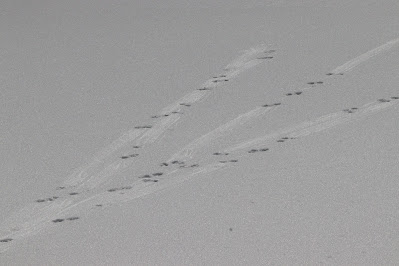Wild Algonquin!
Our mammal highlight during a 2 day visit to the Algonquin Provincial Park region was finding a healthy Red Fox. We were able to view it from the car. Red foxes mainly dine on small mammals, including voles, mice, lemmings, squirrels, hares and rabbits. They will also eat plants and bird eggs.
https://canadiangeographic.ca/articles/animal-facts-red-fox/
We saw several Red Squirrels during our hiking adventures. Red squirrels are omnivores and their diet includes flowers, berries, mushrooms, bugs, mice, eggs, and even small birds!
https://www.aiwc.ca/blog/six-things-to-know-about-red-squirrels/We watched the water for signs of River Otters and Beaver but only found tracks. The wide trail was made by a Beaver's tail that dragged behind in the deep snow, covering up the foot tracks.
A water hole on a lake was an entry and exit point for some beavers. Again, we didn't get to see Canada's largest rodent, but we found the tracks going to and from the hole.
An American Mink swam through the river as we watched from a bridge in Arrowhead Provincial Park, north of Huntsville.
After the swim, he looked back at us, then caught a fish and ran away.
Tiny critters were in abundance on Bat Lake Trail. Although I didn't count them, I would estimate we saw hundreds of thousands of Snow Fleas. They look like black specks sprinkled on the snow. The lower picture is cropped to show detail. They aren't fleas, and although they have 6 legs, they are more closely related to crustaceans than to insects. They produce their own type of antifreeze, allowing them to be active on warmer winter days. They help to decompose organic material and are a good indicator of healthy soil.https://www.farmersalmanac.com/snow-fleas











No comments:
Post a Comment